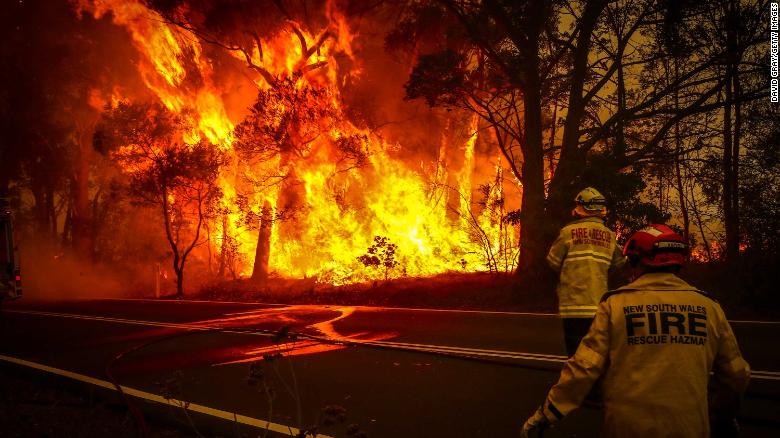Australian bushfires are seasonal and as predictable as the sun rising in the east given favourable climatic conditions. The bushfire season in New South Wales and South Australia peaks in summer and autumn, meaning the worst may be yet to come.
“The greatest danger occurs after the dry winter and spring. The worst conditions occur when deep low-pressure systems near Tasmania bring strong, hot and dry, westerly winds to the coastal districts.
The end of the fire season is determined by the onset of moister conditions, sometimes the result of a tropical cyclone developing near the Queensland coast.”
Australian Bureau of Meteorology
Periods of drought create the perfect environment for fires whipped into uncontrollable fiery maelstroms by strong southeast to northeast winds, fires started by arson or dry lightning strike.
“In some parts of Australia lightning is the main source of bushfire ignition. The winds during thunderstorms can make it hard to predict the behaviour and movement of a bushfire.
Large fires can also create their own thunderstorms known as pyrocumulonimbus. They can cause erratic more intense and dangerous bushfire behaviour.”
The 2019-2020 Australian bushfires have so far, destroyed more bush and wildlife than previous fires but killed fewer people. MSM and the Australian Government Bureau of Meteorology blame this year’s catastrophic fires on climate change, but rural landowners disagree. They blame the Greens’ influence on government policy restricting the cutting of wide fire breaks around homes and forbidding the removal of a buildup of flammable undergrowth in the bush.
According to the Greens, dead trees are a valuable animal habitat not to be disturbed. One hopes the Greens are sufficiently disturbed by the estimated half a million dead animals in the current fires as a result of their “environmentally friendly” policies. The Aborigines are much better at protecting wildlife and restricting bushfires than the Greens because they “used fire for many thousands of years to ‘care for country’. The fires were a tool that encouraged the growth and extent of grasslands to enhance hunting, reduced levels of fuel, and kept vegetation from becoming dense and hard to walk through.”
Suitable conditions mean more of Australia is alight in the 2019-2020 fire season. As at 5 January 2020 an estimated 6.3 million hectares are destroyed with over 2,500 buildings (including over 1,300 houses), and 25 people have died with a further six missing in the state of Victoria. Thankfully fewer lives are lost to date than in previous fires but much more bush and wildlife is being destroyed.
Some notable Australian bushfires:
- 1853 ‘Black Thursday’ on 6 February saw bushfires burn 5 million hectares across Victoria with temperatures of 47 °C (117 °F) recorded at 11am in Melbourne. Twelve human lives were lost, along with one million sheep, thousands of cattle and countless native animals.
- 1891 ‘Red Tuesday’ in February 1891 in South Gippsland saw about 260,000 hectares burnt, 12 people dead and more than 2,000 buildings destroyed.
- 1926 ‘Black Sunday’ on 14 February saw 60 lives lost and over a 1,000 buildings destroyed.
- 1932 Major fires occurred in many districts across Victoria throughout the summer. Large areas of state forest in Gippsland were burned and nine lives were lost.
- 1939 ‘Black Friday’ 13 bushfires in Victoria burned 2 million hectares of land, 71 people dead, 1,300 homes and 3,700 buildings destroyed after a strong northerly wind hit the state causing several of the fires to combine into one massive front. The summer of 1938–39 had been hot and dry and by early January fires were burning in a number of locations across the state (just like this year).
- 1942-1944 was marked by a series of major bushfires following severe drought conditions in the state of Victoria in Australia. The summer of 1943–44 was the driest summer ever recorded in Melbourne until 2002 with just 46 millimetres or 1.81 inches falling, a third of the long-term average. Between 22 December 1943 and 15 February 1944, burnt an estimated one million ha, 51 people were killed, 700 injured, and 650 buildings were destroyed across the state. Many personnel who would have been normally available for fire fighting duties had been posted overseas and to remote areas of Australia during World War I.
- 1966-1967 Australian fires resulted in 62 fatalities, 900 injured, 7,000 left homeless with 4,286 buildings lost.
- 2008-2009 was one of the most fatal seasons. The Black Saturday fires on 7 February at numerous locations in Victoria resulting in 173 fatalities, 2,056 houses lost and 239,637 hectares (592,160 acres) burned.
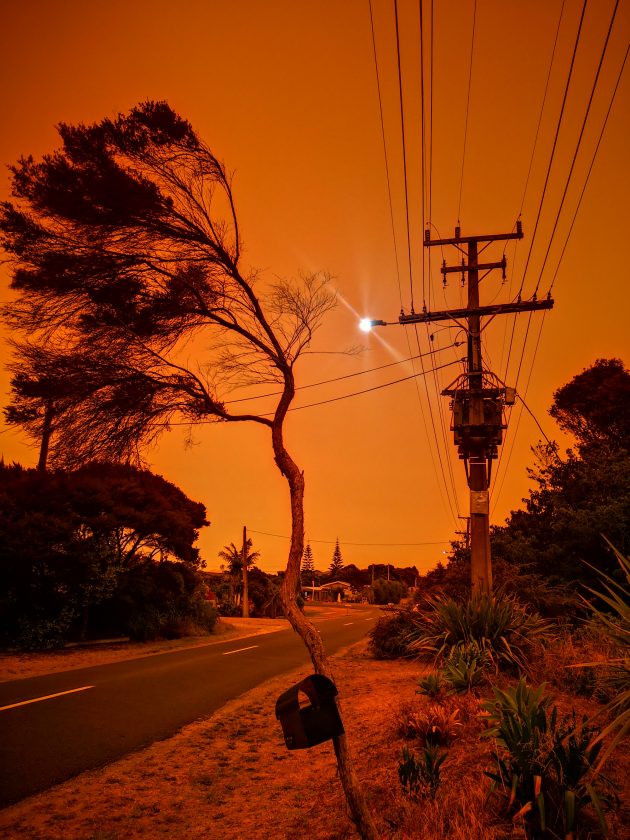
Last week the South Island was shrouded in smoke from the Australian fires and on Sunday mid-afternoon Auckland had an eerie “cloud” cover which darkened the day – a very small taste of our Aussie neighbour’s darkness. The uninformed dialled 111 and MSM surmised on the concept of an apocalypse. They were momentarily distracted from their current favourite doom and gloom subject of the Don’s desire to start world war three.
On TV1 News at Six on Sunday night, Laura James said, “There seems to be no record of smoke from fires in Australia reaching New Zealand before,” despite Stuff reporting in March that Smoke from Australian bush fires had reached New Zealand.
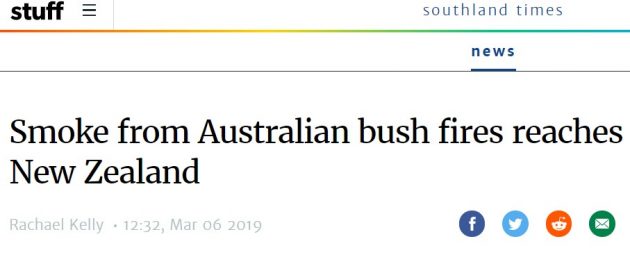
A BFD reader, after being suitably unimpressed by the MSM claim that this was the first instance of Australian bushfire smoke shrouding New Zealand, researched Papers Past.
Thanks to our reader we can enlighten the MSM and tell them to put this in their pipe and smoke it – this year’s Australian bushfire smoke covering New Zealand is not a New Zealand first and nor is it an example of worsening climate change. This clipping from the infamous 1939 fires confirms a similar occurrence.
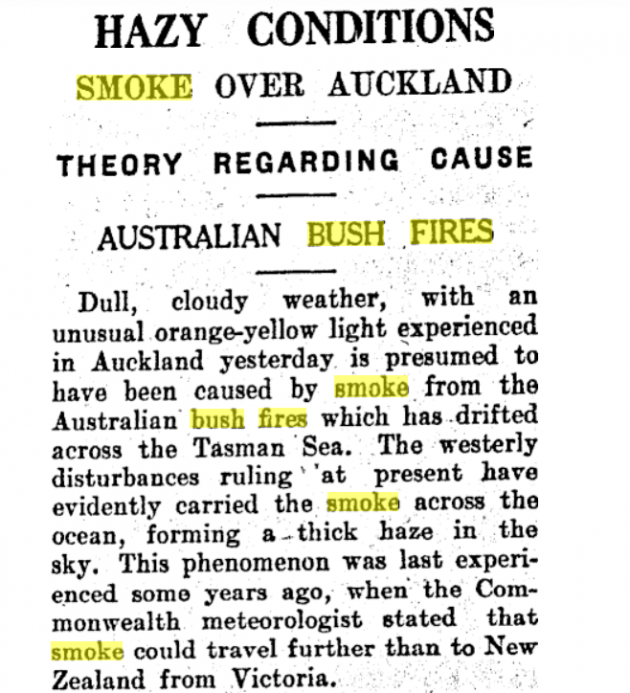
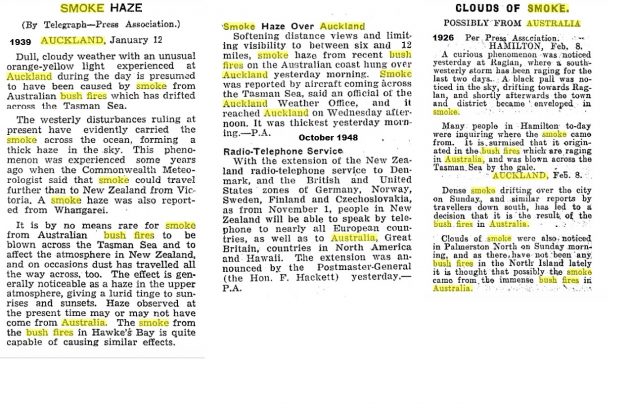
Australian bushfires were reported in New Zealand regional newspapers as far back as 1894. You can access these articles by clicking on this link, this link and this link.
Our BFD reader captured New Zealand articles recording Australian heatwaves, some occurring over a century ago. The temperature in Eucla, New South Wales was 122 degrees Fahrenheit, or 50 degrees Celsius, on December 18, 1912. But Australia’s highest maximum temperature was recorded in South Australia as 50.7 °C (123.3 °F) at Oodnadatta on 2 January 1960.
So much for global warming.

